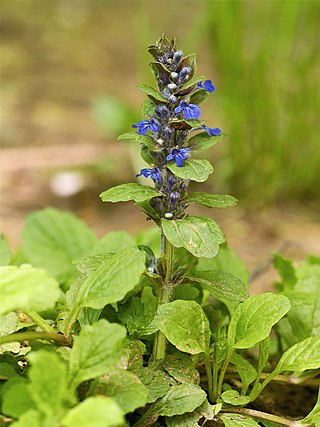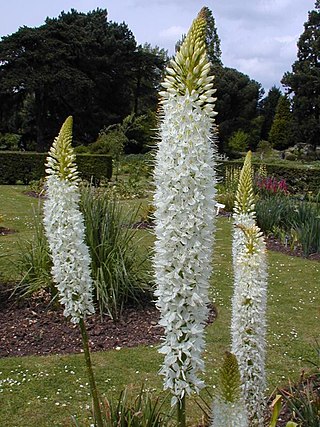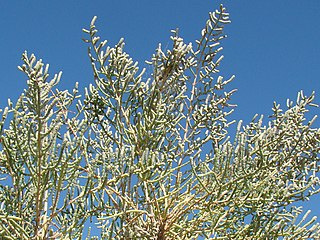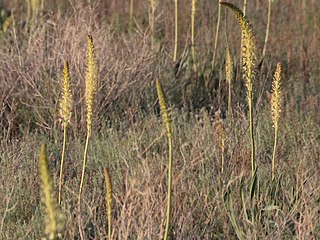
Ajuga, also known as bugleweed, ground pine, carpet bugle, or just bugle, is a genus of flowering plants in the Ajugeae tribe of the mint family Lamiaceae. There are over 60 species of annual or perennial, mostly herbaceous plants. They are native to Europe, Asia, Africa, and Australia.

Gypsophila is a genus of flowering plants in the carnation family, Caryophyllaceae. They are native to Eurasia, Africa, Australia, and the Pacific Islands. Turkey has a particularly high diversity of Gypsophila taxa, with about 35 endemic species. Some Gypsophila are introduced species in other regions.

Senecio vernalis is one of the European species of Senecio, an annual that is also known as eastern groundsel. While it has been long classified as Senecio vernalis, this species has more recently been described as a subspecies of Senecio leucanthemifolius and is now included by some in that species.

Eremurus is a genus of deciduous perennial flowers in the family Asphodelaceae. They are also known as the foxtail lilies or desert candles. They are native to eastern Europe in, and temperate Asia from Turkey to China, with many species in Central Asia.

Asphodeline is a genus of perennial plants in the family Asphodelaceae, first described as a genus in 1830. It is native to the eastern Mediterranean region and the Middle East from Italy and Algeria east to Iran.
Rosa azerbaidshanica is an endemic species of rose, found only in Kalbajar Rayon of Azerbaijan. Most authorities have it as one of the many synonyms of Rosa pulverulenta.

Halostachys is a genus of flowering plants in the plant family Amaranthaceae, containing a single species, Halostachys caspica. The plants are small to medium halophytic shrubs with apparently jointed fleshy stems and scale-like leaves. They are native to Asia and southeastern Europe.

Galium humifusum is a plant species in the Rubiaceae. Its native range stretches from the Black Sea region to Iran, Central Asia, Pakistan, Xinjiang, Mongolia and a few smaller countries. The species has also been regarded as a waif in the wild in Washington state in the United States.

Ziziphora are a genus of annual or perennial herbs or subshrubs in the family Lamiaceae. Ziziphora has aromatic leaves; they are found in open and often xeric habitats in Southern and Eastern Europe, North-West Africa and Asia to the Himalayas and Altai mountains.
Baron Friedrich August Marschall von Bieberstein was an early explorer of the flora and archeology of the southern portion of Imperial Russia, including the Caucasus and Novorossiya. He compiled the first comprehensive flora catalogue of the Crimeo-Caucasian region.

Iris furcata, the forked iris, is a plant species in the genus Iris, it is also in the subgenus Iris. It is a rhizomatous perennial, from the Caucasus mountains, in the countries of Moldavia and the southern Ukraine. It has short, narrow, sword-shaped leaves. A slender stem, that branches beyond the midpoint, holding small purple, deep purple, blue-violet, light blue or violet flowers. It is cultivated as an ornamental plant in temperate regions. It is often regarded as a synonym of Iris aphylla, but it has chromosomal and morphological differences, so it may considered to be a parent species instead.

Trifolium ambiguum, the kura clover or Caucasian clover, is a species of flowering plant in the family Fabaceae. It is native to Ukraine, Crimea, south European Russia, the northern Caucasus, eastern Turkey, Iraq, and Iran, and has been introduced to New South Wales. Planted for forage, once established it is tolerant of close grazing, and is also useful for honey production.

Salix euxina, the eastern crack-willow, is a species of flowering plant in the willow family Salicaceae, native from Turkey to the Caucasus. It was first described by I. V. Belyaeva in 2009. It is one of the parents of the common crack-willow, Salix × fragilis.

Carex tristis is a species of sedge, native to the Caucasus Mountains and adjoining areas. It is the most abundant plant species found on summits.

Geranium albanum, the crested cranesbill or Albanian cranesbill, is a species of flowering plant in the family Geraniaceae, native to the Caucasus and northern Iran. A clumping perennial reaching 50 cm (20 in), the Royal Horticultural Society considers it a good plant to attract pollinators. There is a cultivar, 'Pink and Stripes'.

Astragalus microcephalus is a species of flowering plant in the family Fabaceae, native from Bulgaria to Iran. It was first described by Carl Ludwig Willdenow in 1802. The species and its two subspecies have acquired a large number of synonyms. Under a synonym of Astragalus microcephalus subsp. microcephalus, Astragalus atenicus, plants occurring in Georgia were assessed as "vulnerable".

Rosa pulverulenta, the Cretan rose, is a species of flowering plant in the family Rosaceae. It is native to the Mediterranean, the Caucasus, and western Asia, and it has been introduced to Argentina. An aromatic, compact shrub, its stems are densely covered in larger stiff prickles, smaller needle-like prickles, and bristles of glandular origin.

Heracleum dissectum is a species of flowering plant in the family Apiaceae. It is found in Siberia and adjoining regions of northern Asia.
Eremurus iae is a perennial flowering plant belonging to the family Asphodelaceae, first described by Alexei Ivanovich Vvedensky. It is native to Tajikistan and Uzbekistan. It is included in the Red Book of the Republic of Uzbekistan as a rare, endemic species. It is distributed in the Surxondaryo Region, the Hisar ridge, the Topolondarya basins and the northern slopes of the Boysun mountain.

Eremurus altaicus is a species of flowering plant in the family Asphodelaceae, native from Siberia to Mongolia. It was first described by Peter Simon von Pallas in 1779 as Asphodelus altaicus.

















